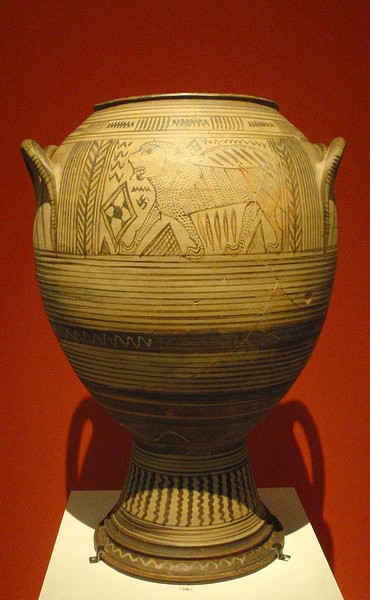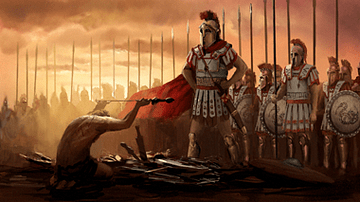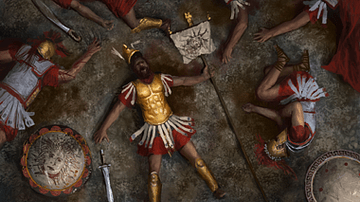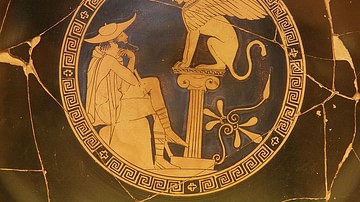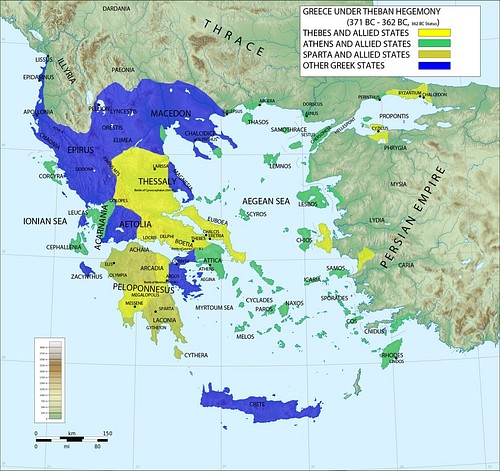
Thebes is a town in central Greece which has been continuously inhabited for five millennia. It was an important Mycenaean centre in the middle to late Bronze Age and was a powerful city-state in the Classical period, participating in both the Persian and Peloponnesian Wars, reaching its peak of influence in the early 4th century BCE when it was the most powerful city in Greece.
THEBES IN MYTHOLOGY
In mythology the city was founded by Kadmos, son of Agenor, brother of Europa, and ancestor of Oedipus. After killing a giant serpent (or dragon) which Ares had sent to protect the Areia Spring, Athena instructed Kadmos to sow the serpent's teeth into the ground from which sprang up warriors who would found the city of Thebes. The myth of Kadmos may hint at the eastern origins of the city, as his name may derive from the Semitic word qedem, meaning east. Also, according to Herodotus, it was Kadmos who introduced the Phoenician script to Greece.
Thebes was, according to legend, the birthplace of the mythological pan-Hellenic hero Hercules. It was also the place where the Sphinx - a mythical creature with a woman's head and a winged lion's body - appeared to terrorize the area until her riddle was solved. Her riddle asked passersby to identify the creature that may have two, three, or four feet, can move in air, water, and on land, and moves more slowly the more feet it has. Oedipus solved the riddle - man - and in a rage the Sphinx leapt to her death from the Theban acropolis.
Another mythological story connected to the city is the legendary expedition of The Seven Against Thebes (and subject of the play of the same name by the 5th century BCE tragedian, Aeschylus). This was traditionally dated a generation before the Trojan War. A war had started between the two sons of Oedipus, Polyneikes had been exiled by his brother Eteokles, and the former enlisted the help of the Achaeans from the Peloponnese to re-take the city. However, when scaling the walls of Thebes, six of the seven champions, including Polyneikes, were killed. Nevertheless, the attackers were successful and the Kadmeians of Thebes fled to the north. Thus a less civilized force took over the citadel. The myth was perhaps a symbolic metaphor for the general situation in Greece following the end of the Mycenaean civilization.
Historical Overview
Strategically situated on a low plateau commanding the surrounding plains of Boeotia, Thebes (also known as Kadmeia) was first inhabited around 3000 BCE. The fact that the modern town lies directly upon the historical site has created difficulties in reconstructing an accurate history for the ancient city. In the early to mid-third millennium, there is evidence of fortified buildings with rock-cut foundations, stone-paved courtyards, mud-brick walls and drains.
From 2500 BCE there is evidence of food and wool production and storage - grinding stones and terracotta loom-weights and spools, and bronze carpentry tools. Trade, both local and further afield, is suggested by the presence of precious goods such as gold, silver, ivory, and Cycladic influenced stone vessels. From 2000 BCE the site expanded with the first presence of stone cists and pits for burials and shaft graves which contained precious objects.
From 1700 BCE the settlement became more dense, and during the 14th century BCE the site reached its Bronze Age peak during the Mycenaean period. There is evidence of palatial buildings of two stories and with wall paintings, greater fortifications (probably of a Cyclopean nature and referred to in Homer's Iliad), workshops (especially for jewellery), and stone-built aqueducts with terracotta pipes. Clay Linear B tablets and seals suggest the site was an important trading centre in olive oil, wood, livestock, wool, and leather goods. Finds of Cretan stirrup jars suggest that contacts were spread across the Aegean. From the 13th century BCE there are also chamber tombs with benches and drains, some with wall paintings and precious grave objects such as gold jewellery and bronze weapons. The end of this period is marked by evidence of earthquake and fire damage.
Following the Dark Ages in Greece (c.1100 to 700 BCE), Thebes re-emerged as an influential Greek city-state and for the next four centuries the city would be a constant rival to Athens and Sparta for regional dominance. In 480 BCE Thebes sided with Persia when Xerxes invaded Greece, and the city was a major protagonist in the Peloponnesian War from 431 to 404 BCE, siding with Sparta against Athens.
In the 4th century BCE, two Theban leaders achieved long lasting fame: Pelopidas, who was the subject of one of Plutarch's Lives, and the brilliant military strategist and student of philosophy, Epaminondas. These two generals, Pelopidas campaigning in central and northern Greece and Epaminondas in the Peloponnese, were largely responsible for Thebes' greatest period of regional dominance.
An unusual feature of the Theban army was the Sacred Band. This was a military corps founded by Gorgidas and consisting of 300 infantrymen linked in homoerotic pairs, the idea being soldiers would fight better if their lover were at their side. The Sacred Band, used for the first time as an independent unit by Pelopidas, defeated the Spartans at the Battle of Tegyra in 375 BCE. Even more decisive was the Battle of Leuktra in 371 BCE, where the Spartans were roundly defeated and where the victory monument set up by the Thebans is still visible today. This was sweet revenge for Sparta's imposition of a garrison at Thebes from 379 to 376 BCE. Victorious, Thebes created a new Arcadian capital at Megalopolis and was now firmly established as the most powerful city-state in Greece. Incidentally, a young Philip, the future king of Macedonia, was captured by Pelopidas whilst campaigning in Thessaly and taken hostage to democratic Thebes where he studied military tactics. The Sacred Band remained undefeated until 338 BCE and the invasion of the Macedonians.
In 364 BCE Pelopidas was killed (but victorious) in the Battle of Kynoskephalai which forced Macedonia to join the Theban led Boeotian League. Shortly after, in 362 BCE, Epaminondas fell in the indecisive Battle of Mantinea against a Spartan and Athenian led alliance. With the loss of their two great generals, Theban dominance began to wane and Sparta and Athens would become the two major players in Greece.
In 338 BCE Thebes joined old rivals Athens and Corinth in order to face the invading Philip (now King) of Macedonia in the Battle of Chaironeia. Thebes ended on the losing side, though, and Philip established a Macedonian garrison in the city. However, Thebes - noted for its scheming against local rivals - was even more harshly treated by Philip's heir, Alexander, who destroyed the city and sold the population into slavery.
